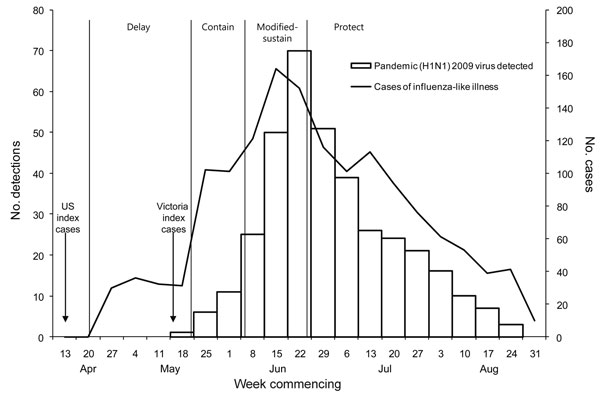Volume 17, Number 6—June 2011
Synopsis
Reality Check of Laboratory Service Effectiveness during Pandemic (H1N1) 2009, Victoria, Australia
Figure 1

Figure 1. Number of patients with influenza-like illness and numbers of laboratory detections of pandemic (H1N1) 2009 derived from primary care physician influenza surveillance together with the phases of the outbreak in Victoria (VIC). The phases are as follows: delay (conduct active surveillance and border control measures), contain (restrict establishment of the pandemic), modified-sustain (minimize transmission and maintain health services), and protect (focus on those at risk for severe outcomes). Modified from (1,2),
References
- Australian Government Department of Health and Ageing. Australian health management plan for pandemic influenza. Canberra (Australia): The Department; 2008. p. 20–2.
- Grant KA, Carville K, Fielding JE, Barr IG, Riddell MA, Tran T, High proportion of influenza B characterizes the 2008 influenza season in Victoria. Commun Dis Intell. 2009;33:328–36.PubMedGoogle Scholar
- Fielding J, Higgins N, Gregory J, Grant K, Catton M, Bergerei I, Pandemic H1N1 influenza surveillance in Victoria, Australia, April–September, 2009. Euro Surveill. 2009;14:pii:19368.
- Jardine A, Conaty SJ, Cretikos MA, Su WY, Gosbell IA, van Hal SJ. Influenza A testing and detection in patients admitted through emergency departments in Sydney during winter 2009: implications for rational testing. [PMID: 20955122]. Med J Aust. 2010;193:455–9.PubMedGoogle Scholar
- Bishop JF, Murnane MP, Owen RO. Australia’s winter with the 2009 pandemic influenza A (H1N1) virus. N Engl J Med. 2009;361:2591–4. DOIPubMedGoogle Scholar
- Lum ME, McMillan AJ, Brook CW, Lester R, Piers LS. Impact of pandemic (H1N1) 2009 influenza on critical care capacity in Victoria. Med J Aust. 2008;191:502–6.PubMedGoogle Scholar
- Victorian Infectious Diseases Reference Laboratory. Sentinel influenza surveillance 2009 [cited 2010 Jun 23]. http://www.vidrl.org.au/surveillance/flu%20reports/flurpt09/flu09.html
- Kelly H. A pandemic response to a disease of predominantly seasonal intensity. Med J Aust. 2009;192:81–3. DOIPubMedGoogle Scholar
Page created: August 03, 2011
Page updated: August 03, 2011
Page reviewed: August 03, 2011
The conclusions, findings, and opinions expressed by authors contributing to this journal do not necessarily reflect the official position of the U.S. Department of Health and Human Services, the Public Health Service, the Centers for Disease Control and Prevention, or the authors' affiliated institutions. Use of trade names is for identification only and does not imply endorsement by any of the groups named above.